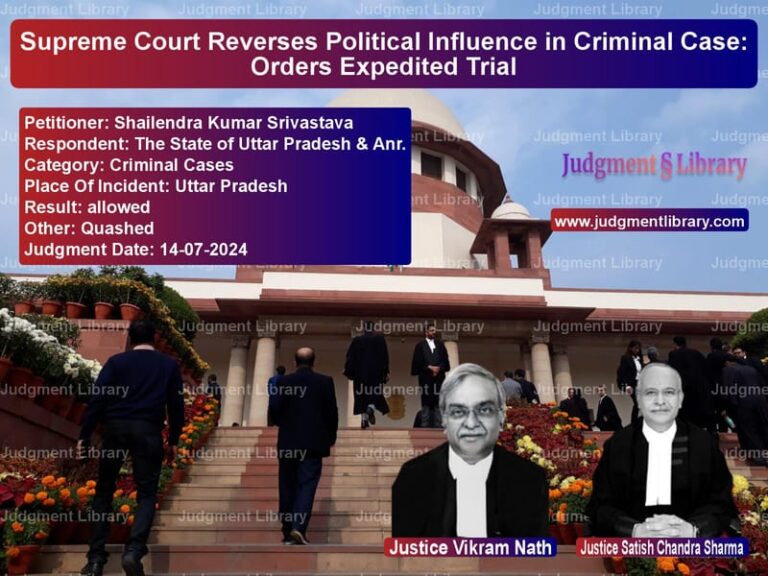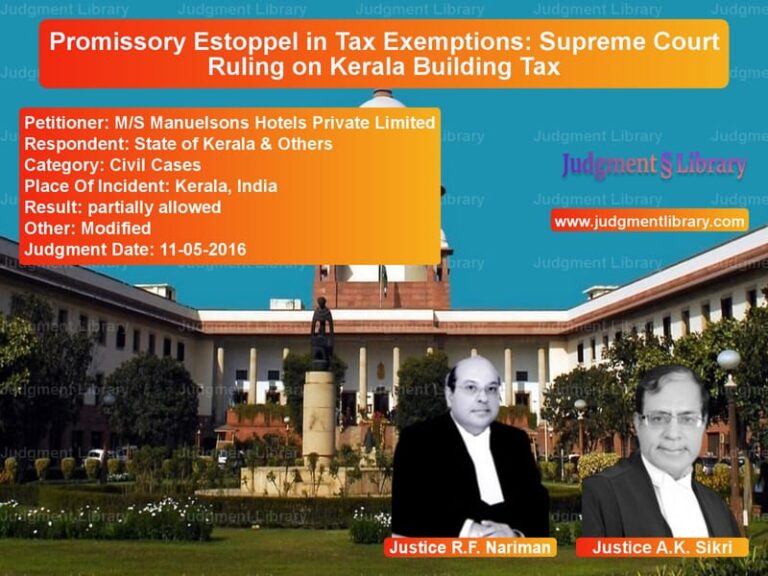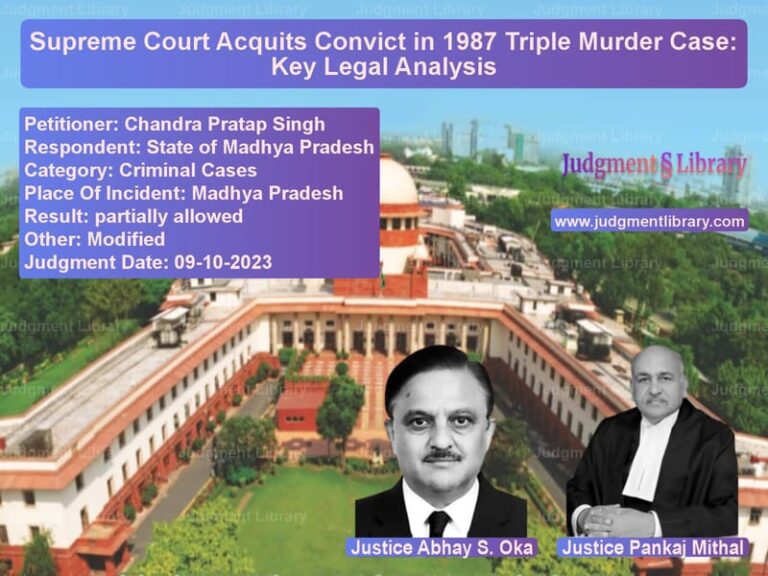Property Tax Valuation: Supreme Court Clarifies Assessment Rules Under Kolkata Municipal Act
The case of Harbanslal Malhotra & Sons Pvt. Ltd. v. Kolkata Municipal Corporation & Anr. revolved around the correct method of determining the annual value of property for taxation purposes under the Kolkata Municipal Corporation Act, 1980. The Supreme Court, in its judgment dated September 5, 2017, examined whether land and building should be assessed separately or as a single unit when determining tax liability.
Background of the Case
The appellant, Harbanslal Malhotra & Sons Pvt. Ltd., owned a property at 226/2 A.J.C. Bose Road, Kolkata, consisting of a two-story building with appurtenant land. The premises were subject to taxation under the Kolkata Municipal Corporation Act, 1980.
The assessment of the property’s annual value for taxation purposes for the years 1988-89 and 1994-95 became a matter of dispute. The Hearing Officer of the Kolkata Municipal Corporation (KMC) determined the valuation as follows:
- For the 1988-89 assessment year: Rs. 59,400
- For the 1994-95 assessment year: Rs. 4,25,600
The appellant contested the valuation, arguing that the assessment was arbitrary and should be calculated as a single unit rather than separately for the land and building.
The matter was taken to the Municipal Assessment Tribunal, which partially ruled in favor of the appellant and reduced the valuation for 1994-95 to Rs. 75,400. However, the Kolkata Municipal Corporation challenged this ruling before the High Court of Kolkata, which set aside the Tribunal’s decision and remanded the case for reassessment, directing that land and building be assessed separately.
Aggrieved by the High Court’s decision, the appellant approached the Supreme Court.
Legal Issues
- Should land and building be assessed separately or as a single unit for tax purposes?
- What is the correct interpretation of Section 174 of the Kolkata Municipal Corporation Act, 1980?
- Was the High Court justified in remanding the case for reassessment?
Arguments by the Appellant (Harbanslal Malhotra & Sons Pvt. Ltd.)
The appellant contended that:
- Under Section 174(1) of the Kolkata Municipal Corporation Act, land and building should be treated as a single unit for determining the annual value.
- The Tribunal had correctly applied the law, and its decision should not have been overturned by the High Court.
- The High Court’s order directing separate assessments of land and building was contrary to the statutory framework.
Arguments by the Respondents (Kolkata Municipal Corporation)
The Kolkata Municipal Corporation argued that:
- Section 174(2) of the Act mandates that land be assessed separately if no building is constructed on it.
- The Tribunal failed to consider this distinction and incorrectly clubbed land and building together.
- The High Court was correct in directing a reassessment based on separate valuations.
Supreme Court’s Analysis
On the Interpretation of Section 174
The Court analyzed Section 174, which provides for determining the annual value of properties:
“Section 174(1) applies to land on which a building is constructed, and the annual value must be determined by considering both as a single unit. Section 174(2) applies to open land, which is to be valued separately at 7% of its estimated market value.”
The Court observed that the High Court’s directive to assess land and building separately was contrary to the statutory scheme.
On the Correctness of the Tribunal’s Decision
The Supreme Court upheld the Municipal Assessment Tribunal’s approach, stating:
“The Tribunal correctly determined the annual value by treating land and building as a single unit, as required by Section 174(1). The High Court erred in directing a reassessment based on separate valuations.”
On the Purpose of Property Taxation
The Court reiterated the principle that property taxation should be based on the fair rental value of the premises as a whole. It held:
“The annual valuation must reflect the property’s reasonable expected rental value. Artificial separation of land and building leads to distortions in tax liability.”
Final Judgment
The Supreme Court set aside the High Court’s decision and restored the Tribunal’s order reducing the assessment valuation to Rs. 75,400. The Court ruled:
“Section 174(1) of the Act mandates that land and building be assessed as a single unit. The High Court’s order remanding the case for reassessment based on separate valuations is contrary to law and must be set aside.”
Conclusion and Impact
This ruling provides clarity on the assessment of property tax under the Kolkata Municipal Corporation Act. It ensures that:
- Land and building are treated as a single unit for valuation purposes.
- Municipal authorities cannot artificially separate land and building to increase tax liability.
- Taxpayers are protected from arbitrary assessments that do not align with statutory provisions.
The judgment reinforces the principle that tax laws must be interpreted in favor of taxpayers when there is ambiguity, ensuring fairness in municipal tax assessments.
Don’t miss out on the full details! Download the complete judgment in PDF format below and gain valuable insights instantly!
Download Judgment: Harbanslal Malhotra vs Kolkata Municipal Co Supreme Court of India Judgment Dated 05-09-2017.pdf
Direct Downlaod Judgment: Direct downlaod this Judgment
See all petitions in Property Disputes
See all petitions in Landlord-Tenant Disputes
See all petitions in Specific Performance
See all petitions in Judgment by R K Agrawal
See all petitions in Judgment by Abhay Manohar Sapre
See all petitions in allowed
See all petitions in supreme court of India judgments September 2017
See all petitions in 2017 judgments
See all posts in Civil Cases Category
See all allowed petitions in Civil Cases Category
See all Dismissed petitions in Civil Cases Category
See all partially allowed petitions in Civil Cases Category







